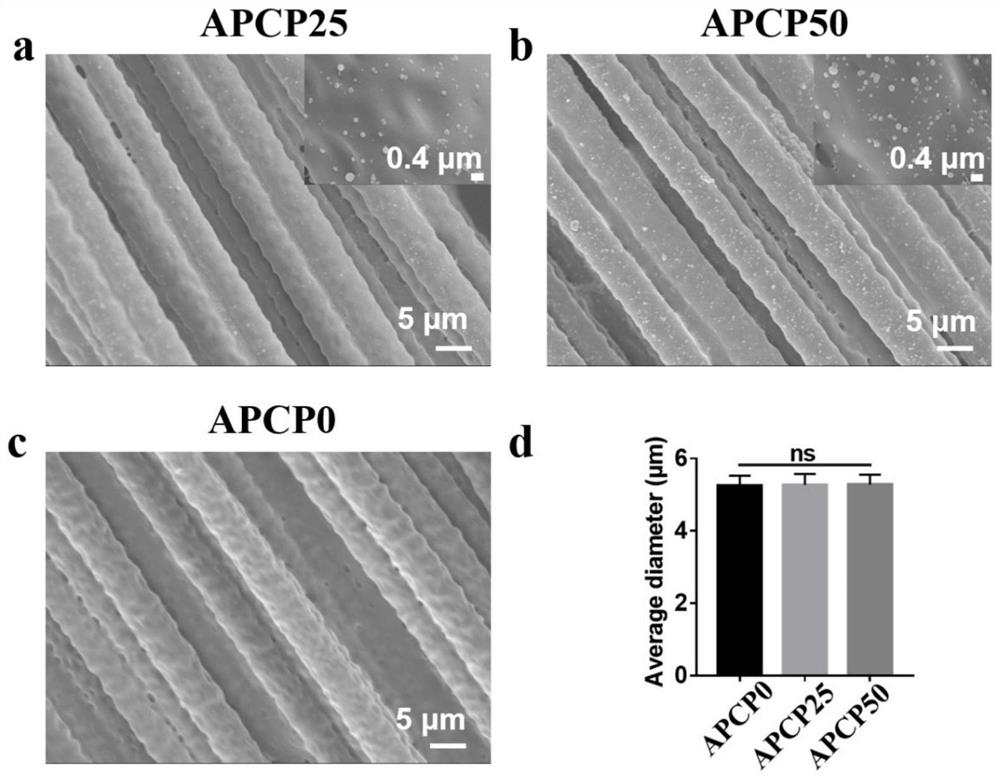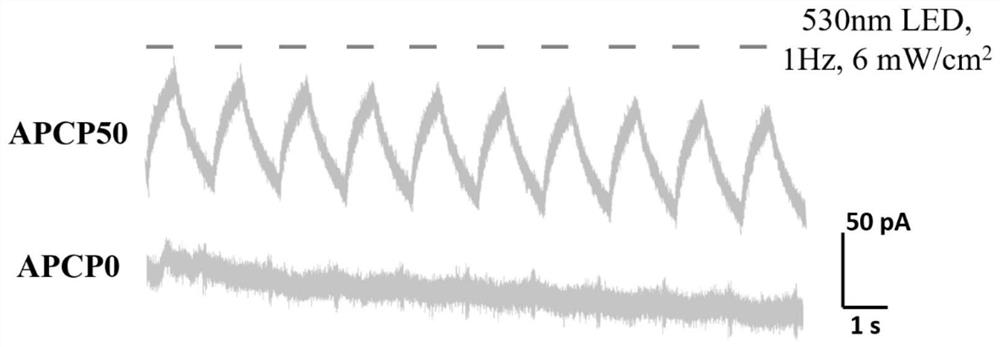Photoelectric response type nanoparticle composite oriented microfiber, cell-loaded photoelectric stimulation nerve scaffold and preparation method of photoelectric response type nanoparticle composite oriented microfiber and cell-loaded photoelectric stimulation nerve scaffold
A nanoparticle and photoelectric response technology, which is applied in the fields of biomedical materials and biomedical engineering, can solve the problems that are difficult to apply to nerve regeneration research, unfavorable cell growth, and limited cytocompatibility, and achieve good application prospects of neural tissue engineering. The effects of enhanced outgrowth and functional expression, simple and efficient preparation method
- Summary
- Abstract
- Description
- Claims
- Application Information
AI Technical Summary
Problems solved by technology
Method used
Image
Examples
Embodiment 1
[0043] In this example, the steps for preparing bioactive photoelectrically responsive nanoparticle composite oriented microfibers are as follows:
[0044] (1) Preparation of hydrophilic P3HT nanoparticles
[0045] At room temperature, P3HT was dissolved in chloroform to form a first solution with a P3HT concentration of 5 mg / mL; SDS was dissolved in deionized water to form a second solution with a concentration of 5 mmol / L, and a cosurfactant was added to the second solution. Propanol forms the third solution (the volume ratio of co-surfactant to the second solution is 1:100); each takes 1 mL of the first solution and the third solution, mixes them, disperses ultrasonically at 125W for 20 minutes, and then evaporates at 65°C for 10 minutes Chloroform forms the P3HT nanoparticle aqueous dispersion, the resulting solution is lyophilized and weighed to determine the product concentration, and a certain amount of deionized water is added to make the nanoparticle concentration 0.2...
Embodiment 2
[0053] In this example, the steps for preparing bioactive photoelectrically responsive nanoparticle composite oriented microfibers are as follows:
[0054] (1) Preparation of hydrophilic P3HT nanoparticles
[0055] At room temperature, P3HT was dissolved in chloroform to form a first solution with a P3HT concentration of 10 mg / mL; SDS was dissolved in deionized water to form a second solution with a concentration of 10 mmol / L, and a cosurfactant was added to the second solution. Propanol forms the third solution (the volume ratio of co-surfactant to the second solution is 1:100); each takes 1 mL of the first solution and the third solution, mixes them, ultrasonically disperses at 125W for 30 minutes, and then evaporates at 65°C for 15 minutes Chloroform forms the P3HT nanoparticle aqueous dispersion, the resulting solution is lyophilized and weighed to determine the product concentration, and a certain amount of deionized water is added to make the nanoparticle concentration 0...
Embodiment 3
[0063] In this example, the steps for preparing bioactive photoelectrically responsive nanoparticle composite oriented microfibers are as follows:
[0064] (1) Preparation of hydrophilic P3HT nanoparticles
[0065] At room temperature, P3HT was dissolved in chloroform to form a first solution with a P3HT concentration of 5 mg / mL; SDS was dissolved in deionized water to form a second solution with a concentration of 5 mmol / L, and a cosurfactant was added to the second solution. Propanol forms the third solution (the volume ratio of co-surfactant to the second solution is 1:100); each takes 1 mL of the first solution and the third solution, mixes them, disperses ultrasonically at 125W for 20 minutes, and then evaporates at 65°C for 10 minutes Chloroform forms the P3HT nanoparticle aqueous dispersion, the resulting solution is lyophilized and weighed to determine the product concentration, and a certain amount of deionized water is added to make the nanoparticle concentration 0.2...
PUM
| Property | Measurement | Unit |
|---|---|---|
| Concentration | aaaaa | aaaaa |
| Particle size | aaaaa | aaaaa |
| Diameter | aaaaa | aaaaa |
Abstract
Description
Claims
Application Information
 Login to View More
Login to View More - Generate Ideas
- Intellectual Property
- Life Sciences
- Materials
- Tech Scout
- Unparalleled Data Quality
- Higher Quality Content
- 60% Fewer Hallucinations
Browse by: Latest US Patents, China's latest patents, Technical Efficacy Thesaurus, Application Domain, Technology Topic, Popular Technical Reports.
© 2025 PatSnap. All rights reserved.Legal|Privacy policy|Modern Slavery Act Transparency Statement|Sitemap|About US| Contact US: help@patsnap.com



